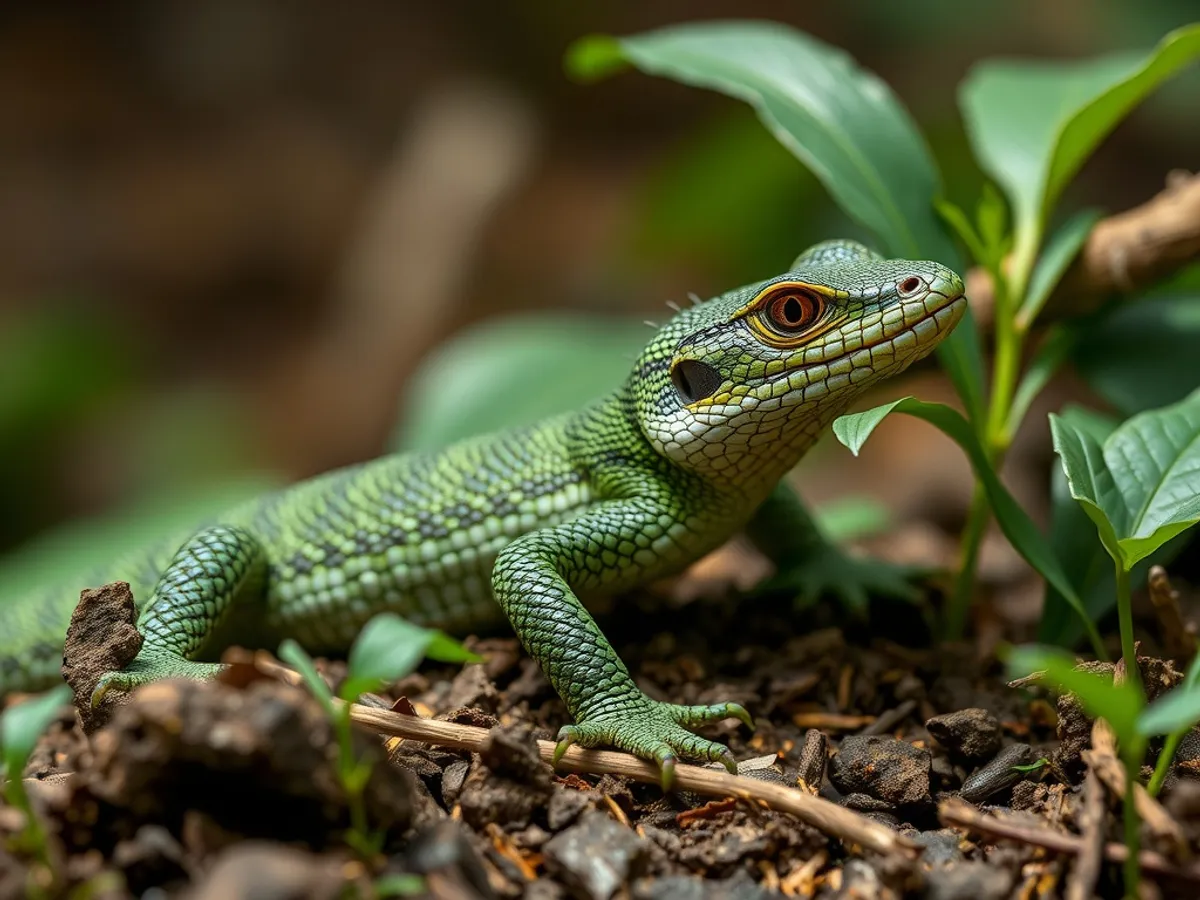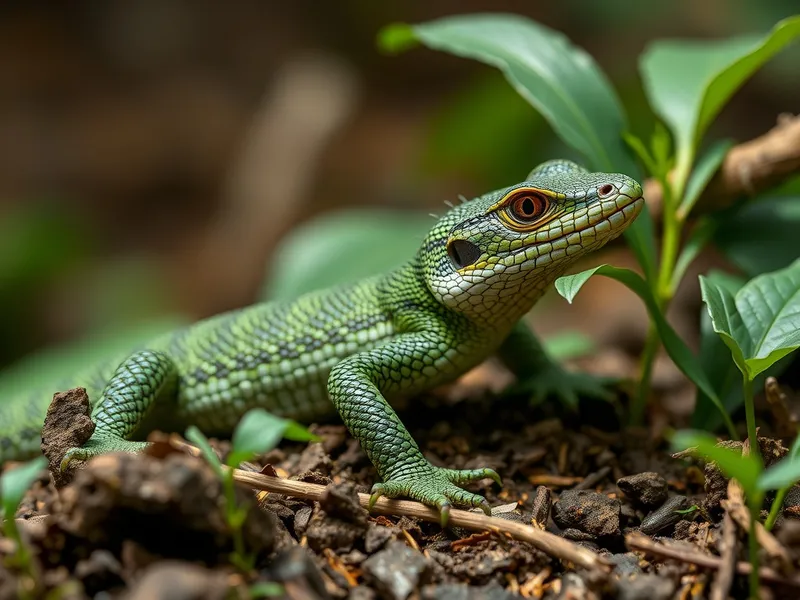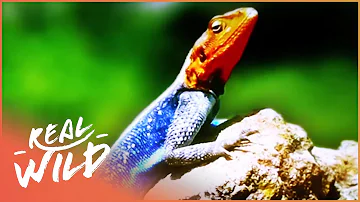
Mexican Alligator Lizard
Abronia graminea

Meet the Mexican Alligator Lizard
The Mexican alligator lizard is a strikingly colored arboreal reptile native to the cloud forests of eastern Mexico. Known for its bright emerald-green scales and alligator-like appearance, this lizard spends most of its life in the trees, where it hunts insects among the foliage. With a prehensile tail and dexterous limbs, it is perfectly adapted for life in the forest canopy. These lizards are diurnal, secretive, and play an important role in their ecosystem by controlling insect populations.
Classification
Reptile
Habitat
Montane cloud forests
Diet
Carnivore
Lifespan
10-15 years
Conservation
Endangered
Weight
20-40 grams
📖Fascinating Facts
Arboreal Lifestyle
Mexican alligator lizards spend almost their entire lives in the treetops of cloud forests, rarely descending to the ground.
Live Birth
Unlike most reptiles, this species gives birth to live young, a rare trait among lizards.
Master of Camouflage
Their bright green scales blend seamlessly with moss and leaves, helping them evade predators.
📋Detailed Description
The Mexican Alligator Lizard (Abronia graminea) is a medium-sized, arboreal lizard distinguished by its vivid emerald-green coloration, which provides effective camouflage among the mosses and epiphytes of its montane cloud forest habitat. Adults typically measure 8 to 12 inches (20–30 cm) in total length, with a slender, elongated body and a robust, prehensile tail that accounts for nearly half their length. The head is broad and angular, with pronounced, keeled scales that give it a rough, armored appearance reminiscent of an alligator, hence the common name. Their limbs are well-developed, ending in long, dexterous toes equipped with sharp claws for gripping branches. The skin is covered in overlapping, osteoderm-reinforced scales, offering protection against predators and environmental hazards. Primarily diurnal, Abronia graminea is most active during the cool, misty mornings and late afternoons, spending much of its time motionless among bromeliads and dense foliage. It is a solitary species, except during the breeding season, and exhibits territorial behavior, especially among males. The species is viviparous, giving birth to live young rather than laying eggs, a rare adaptation among lizards that may be linked to the cool, moist conditions of its high-elevation environment. Its specialized adaptations and restricted range make it highly sensitive to habitat disturbance, underscoring its status as an endangered species.
💡 Did you know?
Despite their alligator-like appearance, Mexican alligator lizards are harmless and are more closely related to typical lizards than to crocodilians.
🔬Research & Sources
🎭Behavior & Social Structure
Abronia graminea is an arboreal and primarily diurnal lizard, spending the majority of its life in the upper canopy of cloud forests at elevations between 1,200 and 2,400 meters. It is an ambush predator, remaining motionless for extended periods and relying on its cryptic coloration to avoid detection by both prey and predators. When hunting, it feeds on a variety of invertebrates, including insects (beetles, caterpillars, orthopterans), spiders, and occasionally small vertebrates such as nestling birds. Social interactions are generally limited outside of the breeding season, with individuals maintaining exclusive territories. Males may display aggressive behaviors, such as head-bobbing and open-mouth displays, to deter rivals. The species is known for its secretive nature and slow, deliberate movements, which help minimize detection. During cooler periods or inclement weather, individuals may seek shelter in bromeliads or tree crevices, where humidity remains high and temperatures are buffered.
👶Reproduction & Life Cycle
Mexican Alligator Lizards are viviparous, with females giving birth to live young rather than laying eggs—a trait believed to be an adaptation to the cool, moist conditions of their montane habitat. Mating typically occurs during the early rainy season (April–June), with males engaging in courtship behaviors that include gentle biting and tactile stimulation. After successful copulation, gestation lasts approximately 6–8 months. Females give birth to litters of 5–12 fully formed juveniles, usually between October and December. Neonates are independent from birth and receive no parental care. Sexual maturity is reached at approximately 2–3 years of age. Breeding success is closely tied to environmental stability, with habitat disturbance and climate fluctuations negatively impacting reproductive rates.
🛡️Adaptations & Survival
Abronia graminea exhibits a suite of adaptations for an arboreal lifestyle in cloud forests. Its prehensile tail and elongated limbs with sharp claws enable secure movement among branches and epiphytes. The bright green coloration provides camouflage among mosses and bromeliads, while the keeled, osteoderm-reinforced scales offer protection against predators and minor injuries. Viviparity (live birth) is a key evolutionary adaptation, allowing successful reproduction in the cool, humid conditions where egg incubation would be challenging. The species also has a relatively low metabolic rate, which may be advantageous in the cool, resource-limited montane environment. Its cryptic behavior and slow movements further reduce predation risk.
📚Research Sources
🎨Cultural Significance
While Abronia graminea does not have a prominent role in indigenous mythology or traditional medicine, its remarkable appearance has made it a symbol of Mexico's unique biodiversity. It is occasionally featured in local environmental education programs as an ambassador for cloud forest conservation. In recent years, its popularity in the exotic pet trade has raised awareness of the species, but also contributed to over-collection and illegal trafficking. Conservation organizations now use the lizard's image to promote habitat preservation and responsible wildlife stewardship.
🔬Recent Research & Discoveries
Recent research has focused on the genetic diversity and phylogenetic relationships within the genus Abronia, revealing significant cryptic diversity and underscoring the need for taxonomic revision. Studies on the species' reproductive biology have provided insights into the evolution of viviparity in high-elevation reptiles. Conservation research has highlighted the critical importance of microhabitat features, such as bromeliad abundance and canopy connectivity, for population viability. Ongoing monitoring efforts are assessing the impact of climate change on cloud forest ecosystems and modeling future distribution scenarios for Abronia graminea. Captive breeding protocols have been refined to improve reproductive success and reduce pressure on wild populations.
🎥Wildlife Videos

Wildlife | Episode 2: Crocodiles, Alligators, Caimans & Gharials | Free Documentary Nature
Wildlife: Episode 2 - Crocodiles, Alligators, Caimans & Gharials | Wildlife Documentary Watch 'Wildlife - Episode 3: Kangaroos' ...
Free Documentary - Nature

Wildlife - Just Reptiles | Free Documentary Nature
Wildlife - Episode 3: Just Reptiles | Wildlife Documentary Watch 'Wildlife - Episode 4' here: https://youtu.be/SNRyvGzDsww ...
Free Documentary - Nature

Rivers of Death (Full Episode) | World's Deadliest
Rivers bring water, the element essential to all life. But wherever they flow, killers prowl, hidden just below the surface waiting to ...
Nat Geo Animals

Australia’s Remarkable Reptiles - Lizards of Oz | Full Documentary
Australia is the driest inhabited continent on the planet with much of the inland being a virtual desert. However, cold blooded ...
Free High-Quality Documentaries

The Strange World Of Lizards (Wildlife Documentary) | Wild About | Real Wild
Lizards are some of the world's most fascinating creatures. Join us as we learn all about these strange creatures and learn how ...
Real Wild

Wildlife Instincts: Survival Techniques - Iguana vs. Basilisk | Free Documentary Nature
Wildlife Instincts - Episode 2: Survival Techniques - Iguana vs Basilisk | Free Documentary Nature Watch "Wildlife Instincts: The ...
Free Documentary - Nature
🌍Habitat Information
The Mexican Alligator Lizard typically inhabits Montane cloud forests environments. Mexican Alligator Lizards have adapted to their environments with specialized features and behaviors.
Primary Habitat:
Montane cloud forests
More detailed habitat information will be available soon.
🛡️Conservation Status
The Mexican Alligator Lizard is currently classified as Endangered. Conservation efforts are crucial for preserving this species for future generations.
Common Threats:
- 🏠Habitat loss and fragmentation
- 🌡️Climate change impacts
- 🎯Hunting and poaching
- 🏭Human-wildlife conflict
⚠️Threats & Conservation Challenges
The primary threats to Abronia graminea are habitat loss and fragmentation due to deforestation for agriculture, logging, and urbanization in the Sierra Madre Oriental of Veracruz and Puebla. Illegal collection for the international pet trade has also significantly impacted wild populations, as the species' striking appearance makes it highly sought after. Climate change poses an additional threat by altering the delicate microclimate of cloud forests, potentially reducing suitable habitat. Population trends are declining, with the IUCN Red List categorizing the species as Endangered. Conservation challenges include enforcing habitat protection, curbing illegal trade, and promoting sustainable land use practices. Captive breeding programs have been established, but reintroduction success is limited by ongoing habitat degradation.
🔬Scientific Classification
Scientific Name
Abronia graminea
Classification Hierarchy
🔍 About Taxonomic Classification
Taxonomic classification is a hierarchical system used by scientists to classify and organize living organisms based on shared characteristics and evolutionary relationships.
The system moves from broad categories (Kingdom) to increasingly specific ones, with each animal's scientific name typically consisting of its Genus and species.
📝Community Notes
Share your observations and insights about the Mexican Alligator Lizard with our community of wildlife enthusiasts.
Join Our Community
Sign in to share your observations and connect with fellow wildlife enthusiasts.
Sign In to ContributeNo community notes yet
Be the first to share your observations about the Mexican Alligator Lizard!
Explore Mexican Alligator Lizard
Select a tab above to learn more about this amazing animal.
📸Photo Gallery
No photos available for this animal yet.
🌟Discover More Wildlife
Continue your journey of discovery with more fascinating animals from our database
